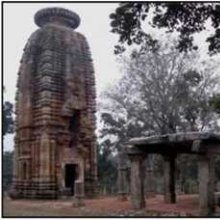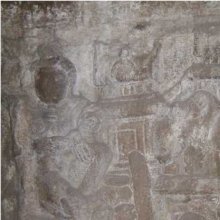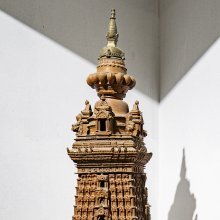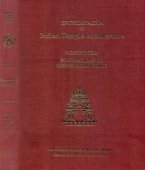Shikhara, Sikhara, Śikhara: 36 definitions
Introduction:
Shikhara means something in Buddhism, Pali, Hinduism, Sanskrit, the history of ancient India, Marathi, Hindi. If you want to know the exact meaning, history, etymology or English translation of this term then check out the descriptions on this page. Add your comment or reference to a book if you want to contribute to this summary article.
Shikhara has 36 English definitions available.
The Sanskrit term Śikhara can be transliterated into English as Sikhara or Shikhara, using the IAST transliteration scheme (?).
Alternative spellings of this word include Shikhar.
Images (photo gallery)
Languages of India and abroad
Sanskrit dictionary
[Deutsch Wörterbuch]
Source: Cologne Digital Sanskrit Dictionaries: Böhtlingk and Roth Grosses Petersburger WörterbuchŚikhara (शिखर):—(von śikhā) gaṇa aśmādi zu [Pāṇini’s acht Bücher 4, 2, 80.]
1) adj. spitzig, zackig: keśairarālairdaśanaiḥ śikharaiḥ [Kathāsaritsāgara 45, 235.] daśanā [Meghadūta 80] (nach einem [Scholiast] Zähne wie Jasminknospen habend). śikharamutpalam = karkaṭaśṛṅgī [AUSH. 95.] Vgl. śikharin . —
2) m. n. gaṇa ardharcādi zu [Pāṇini’s acht Bücher 2, 4, 31.] [Trikāṇḍaśeṣa 3, 5, 10.] a) Spitze eines Berges [Amarakoṣa 2, 3, 4.] [Trikāṇḍaśeṣa 3, 3, 374.] [Hemacandra’s Abhidhānacintāmaṇi 1032.] [Hemacandra’s Anekārthasaṃgraha 3, 610. fg.] [Medinīkoṣa r. 227. fg.] [Halāyudha 2, 11.] giri [Śāṅkhāyana’s Brāhmaṇa 26, 1.] uttama [Weber’s Indische Studien 2, 194.] [Mahābhārata 1, 1185. 3, 2441.] [Harivaṃśa 6937.] [Rāmāyaṇa 2, 33, 26. 56, 10. 69, 8. 94, 4. 3, 61, 8. 68, 13. 4, 1, 9. 8, 5. 5, 87, 8] (masc.). [6, 83, 42] (masc.). [Kumārasaṃbhava 5, 7.] [Meghadūta 18. 75.] [Śākuntala 167.] [Vikramorvaśī 10, 6.] [Spr. (II) 1193. 4564.] [Varāhamihira’s Bṛhajjātaka S. 12, 1. 16, 35. 24, 2.] [Kathāsaritsāgara 18, 395. 22, 224. 31, 25.] [Rājataraṅgiṇī 4, 166.] [Oxforder Handschriften 52], b, [?11. fg. Bhāgavatapurāṇa 5, 16, 17. ŚUK. in Lassen’s Anthologie (III) 32, 17. Pañcatantra 120, 9.] valmīka [9, 7.] eines Baumes [Amarakoṣa 2, 4, 1, 12.] [Trikāṇḍaśeṣa 2, 3, 2. 3, 3, 374.] [Hemacandra’s Abhidhānacintāmaṇi 1121.] [Hemacandra’s Anekārthasaṃgraha] [Medinīkoṣa] [Halāyudha 2, 26.] [Harivaṃśa 6956.] [Rāmāyaṇa 3, 79, 2. 22.] [Spr. (II) 1312. 4929.] [Varāhamihira’s Bṛhajjātaka S. 28, 8.] Giebel, Zinne oder Thurm (eines Palastes, eines Tempels u.s.w.) [Rāmāyaṇa 2, 33, 3.] [Rāmāyaṇa Gorresio 1, 5, 13. 2, 57, 18. 6, 104, 10.] [Spr. (II) 2161.] [Varāhamihira’s Bṛhajjātaka S. 56, 21. 27.] [Kathāsaritsāgara 114, 19.] [Prabodhacandrodaja 79, 12.] [Bhāgavatapurāṇa 1, 10, 16. 3, 23, 18. 4, 9, 56.] pṛṣṭha ein berghoher Rücken (eines Elephanten) [Spr. (II) 1324.] puccha äusserste Spitze des Schwanzes (beim Fisch) [Oxforder Handschriften 129], a, [No. 232.] daśana Zahnspitze [Gītagovinda 1, 7.] dhvajasya [Rājataraṅgiṇī 3, 77.] abhra [Mahābhārata 1, 1112. 13, 836.] vīci [Varāhamihira’s Bṛhajjātaka S. 27, 1.] jvalana 2. ein spitzer Gegenstand z. B. ein Nagel [Śāṅkhāyana’s Śrautasūtrāṇi 14, 22, 9.] — b) das Sträuben der Härchen am Körper (s. pulaka) [Trikāṇḍaśeṣa 3, 3, 374.] [Hemacandra’s Anekārthasaṃgraha] [Medinīkoṣa] — c) ein Rubinstückchen von der Farbe eines reifen Granatkerns (pakvadāḍimabījābhamāṇikyaśakala) diess. — d) Achselgrube [Trikāṇḍaśeṣa] [Medinīkoṣa] wohl eher Achsel; vgl. bāhu, bhuja . —
3) m. eine best. Stellung der Hand [Oxforder Handschriften 86,a,27. 202,a,6.] —
4) n. Gewürznelke [AUSH. 77.] —
5) n. Bez. eines best. mythischen Geschosses (astra) [Rāmāyaṇa 1, 29, 11.] —
6) m. Nomen proprium eines Mannes [Kathāsaritsāgara 67, 48.] —
7) f. ā a) Sanseviera Roxburghiana Schult. [Śabdacandrikā im Śabdakalpadruma] — b) N. einer best. mythischen Keule (gadā) [Rāmāyaṇa 1, 29, 8.] — Vgl. tri, bāhu ( [Harivaṃśa 4205]), bhuja, vahni, vaiḍūrya, śekhara .
Sanskrit, also spelled संस्कृतम् (saṃskṛtam), is an ancient language of India commonly seen as the grandmother of the Indo-European language family (even English!). Closely allied with Prakrit and Pali, Sanskrit is more exhaustive in both grammar and terms and has the most extensive collection of literature in the world, greatly surpassing its sister-languages Greek and Latin.
See also (Relevant definitions)
Starts with (+4): Shikhara-sammelana, Shikhara-varta, Shikharabha, Shikharadashana, Shikharadati, Shikharadatta, Shikharadhara, Shikharadri, Shikharagira, Shikharahasta, Shikharaja, Shikharalakshana, Shikharamani, Shikharana, Shikharane, Shikharanicaya, Shikharapurisa Janem, Shikharasena, Shikharasvamin, Shikharasvamini.
Ends with (+26): Arbudashikhara, Astashikhara, Atavishikhara, Bahushikhara, Bhujashikhara, Candrakumarashikhara, Dashanashikhara, Dohshikhara, Dosshikhara, Dvishikhara, Gaurishikhara, Gayashikhara, Girisikhara, Gokshiravarashikhara, Himadrishikhara, Himashikhara, Himavacchikhara, Jihvashikhara, Jvalantashikhara, Kailasashikhara.
Full-text (+173): Shikharavasini, Sahasrashikhara, Shailashikhara, Vahnishikhara, Atavishikhara, Dohshikhara, Girisikhara, Bahushikhara, Astashikhara, Trishikhara, Vimana, Griva, Bhujashikhara, Stupi, Raghurama, Jvalantashikhara, Pabbatasikhara, Shikharin, Shikharasena, Shikharasvamini.
Relevant text
Search found 39 books and stories containing Shikhara, Sikhara, Śikhara, Śikharā, Sikhāra; (plurals include: Shikharas, Sikharas, Śikharas, Śikharās, Sikhāras). You can also click to the full overview containing English textual excerpts. Below are direct links for the most relevant articles:
Vishnudharmottara Purana (Art and Architecture) (by Bhagyashree Sarma)
8. Characteristic Features of Sarvatobhadra Temple < [Chapter 4 - Temple Building]
5. Different Parts of a Temple < [Chapter 4 - Temple Building]
1.3. Elements of Drama (e): Gatiprasāra (gait extension) < [Chapter 3 - Drama and Dance]
Early Chola Temples (by S. R. Balasubrahmanyam)
Sikhara < [Chapter XIII - Prasada: Component Parts]
Temples in Melpadi < [Chapter IX - Temples of Rajaraja I’s Time]
Temples in Nangavaram (about the 10th year) < [Chapter X - Historical Survey]
Vastu-shastra (5): Temple Architecture (by D. N. Shukla)
Śikharottama Prāsādas (Nāgara Temples)—The evolution of Śikhara < [Chapter 12 - History of Hindu Temples (Prāsādas and Vimānas)]
Temple architecture in Siam (Thailand) < [Chapter 12 - History of Hindu Temples (Prāsādas and Vimānas)]
The Temples of Deccan (1100-1300 A.D.) < [Chapter 12 - History of Hindu Temples (Prāsādas and Vimānas)]
Kashyapa Shilpa-shastra (study) (by K. Vidyuta)
4 (b). Technical terms for the component parts of the temple < [Chapter 2 - Author and his Works]
6. Components in the Storeys of the Gopuras < [Chapter 5 - Gopura Lakṣaṇa]
3. Temple Architecture (Prāsāda or Vimānā) < [Chapter 1 - Introduction]
Temples of Munnur (Historical Study) (by R. Muthuraman)
Sri Kamatchi Amman Shrine < [Chapter 4]
Sri Prakannayagi Amman Shrine < [Chapter 4]
Adavalleswarar or Adavalleeswarar Temple (Architecture) < [Chapter 4]
Samarangana-sutradhara (Summary) (by D. N. Shukla)
Related products





